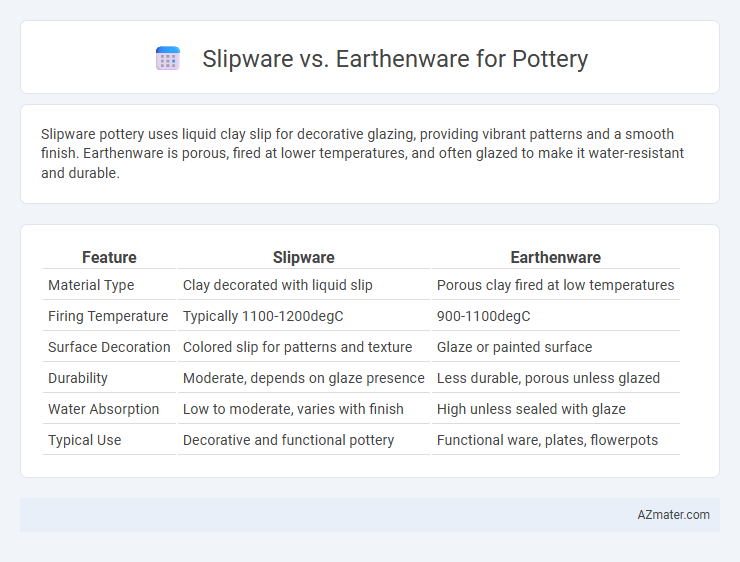Slipware pottery uses liquid clay slip for decorative glazing, providing vibrant patterns and a smooth finish. Earthenware is porous, fired at lower temperatures, and often glazed to make it water-resistant and durable.
Table of Comparison
| Feature | Slipware | Earthenware |
|---|---|---|
| Material Type | Clay decorated with liquid slip | Porous clay fired at low temperatures |
| Firing Temperature | Typically 1100-1200degC | 900-1100degC |
| Surface Decoration | Colored slip for patterns and texture | Glaze or painted surface |
| Durability | Moderate, depends on glaze presence | Less durable, porous unless glazed |
| Water Absorption | Low to moderate, varies with finish | High unless sealed with glaze |
| Typical Use | Decorative and functional pottery | Functional ware, plates, flowerpots |
Understanding Slipware and Earthenware
Slipware is a type of pottery decorated with slip, a liquid mixture of clay and water applied before firing, which allows intricate designs and textured surfaces. Earthenware refers to pottery made from porous clay fired at lower temperatures, typically between 1,000degC and 1,150degC, resulting in a more porous and less durable ceramic body. Understanding slipware involves recognizing the decorative layering technique, while earthenware emphasizes the clay body's composition and firing process.
Key Differences Between Slipware and Earthenware
Slipware pottery is distinguished by its decorative technique that involves applying liquid clay slip to the surface before firing, creating intricate patterns and contrasting colors. Earthenware refers to a broader category of low-fired pottery made from porous clay, often unglazed or simply glazed, resulting in a porous and less durable finish compared to stoneware or porcelain. Key differences include the decorative emphasis on slip application in slipware versus the functional, everyday use characteristic of earthenware vessels.
Historical Background of Slipware and Earthenware
Slipware pottery, originating in ancient China and later flourishing in Medieval Europe, is characterized by the application of liquid clay slip to decorate or coat earthenware vessels, enhancing both aesthetic appeal and surface durability. Earthenware, one of the oldest ceramic types dating back to prehistoric times, is crafted from porous clay fired at lower temperatures, widely utilized across ancient civilizations for everyday functional items. The historical development of slipware reflects advancements in decorative techniques, while earthenware's enduring presence signifies its fundamental role in domestic and cultural practices throughout human history.
Materials Used in Slipware and Earthenware
Slipware pottery uses a clay body coated with liquid clay slip made from refined clay mixed with water, enhancing surface decoration and texture, while earthenware consists of porous, low-fired clay rich in iron and other minerals, giving it a typically reddish-brown color. The slip in slipware allows for intricate designs and smoother finishes, whereas earthenware's coarse composition offers durability and rustic appeal. Both materials are predominantly fashioned from natural clays, but slipware emphasizes surface treatment through slips, contrasting with earthenware's straightforward clay body composition.
Techniques in Slipware Decoration
Slipware decoration utilizes liquid clay slip applied through techniques like trailing, painting, or dipping to create intricate surface designs, enhancing texture and color contrast on pottery. This method contrasts with typical earthenware glazing, as slipware allows for greater control over patterns and finer detail before firing. The precision in slip application makes slipware especially suitable for decorative motifs that are both durable and visually striking.
Firing Processes: Slipware vs Earthenware
Slipware pottery involves applying a liquid clay slip decoration onto a clay body before firing, typically at lower temperatures around 1,000degC to 1,150degC, which allows for vibrant slip designs to mature without melting. Earthenware is fired at similar low temperatures but primarily focuses on the clay body itself, resulting in a porous and softer ceramic that requires glazing to become waterproof. Both firing processes occur in oxidation or reduction atmospheres, but slipware's slip decoration demands careful temperature control to preserve the surface patterns during firing.
Durability and Functionality Compared
Slipware typically features a decorative slip coating that enhances surface texture but may slightly reduce overall durability compared to earthenware. Earthenware is denser and more porous, making it less resistant to water absorption but highly functional for everyday use due to its robustness. In terms of durability and functionality, slipware is best suited for decorative pieces, while earthenware offers better long-term usability in practical applications.
Common Uses in Pottery Practices
Slipware pottery commonly features decorative surfaces where liquid clay slip is applied for intricate designs, making it ideal for artistic and ornamental ceramics. Earthenware, being porous and fired at lower temperatures, is widely used for functional items such as flower pots, kitchenware, and rustic tableware due to its affordability and ease of crafting. Both slipware and earthenware serve distinct roles in pottery, with slipware emphasizing aesthetic appeal and earthenware prioritizing everyday utility.
Artistic Expression: Aesthetic Qualities
Slipware offers vibrant surface decoration through the application of colored slip, allowing intricate patterns and dynamic contrasts that enhance artistic expression. Earthenware's porous, warm-toned body provides a rustic, earthy aesthetic that emphasizes natural textures and hand-crafted imperfections. Both mediums enable distinct artistic qualities, with slipware favoring bold, graphic designs and earthenware highlighting organic, tactile beauty.
Choosing Between Slipware and Earthenware for Your Projects
Slipware offers a decorative surface achieved by applying liquid clay slip, ideal for intricate designs and artistic finishes. Earthenware, known for its porous and robust nature, provides durability and ease of glazing, making it suitable for functional pottery. Selecting between slipware and earthenware depends on your project's aesthetic goals and practical requirements, with slipware excelling in visual detail and earthenware in everyday usability.

Infographic: Slipware vs Earthenware for Pottery
 azmater.com
azmater.com